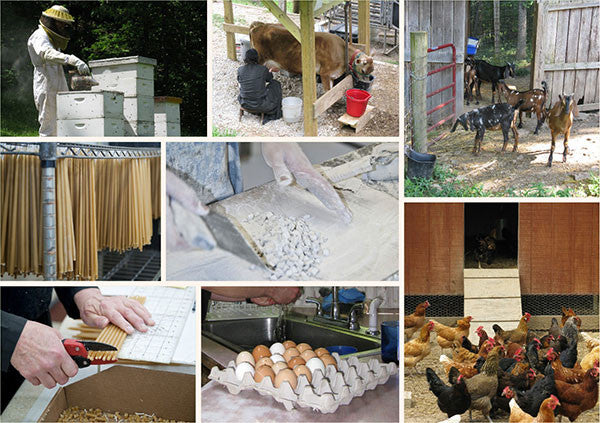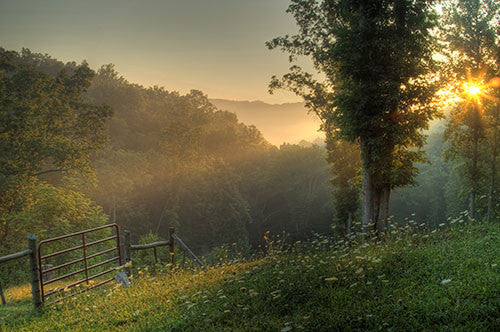Our Story
English | Русский

Holy Cross Monastery is an English-speaking monastery under the jurisdiction of the Russian Orthodox Church Outside of Russia in the Diocese of Eastern America & New York. The abbot of the monastery is Igumen Gabriel.
Holy Cross is a growing monastery consisting of more than two dozen monks, novices, candidates, and lay workers, most of whom are converts to the Orthodox Faith. The monastery community is comprised of both seasoned monks who have lived very full monastic lives for decades, and many younger monks who have brought to the monastery a youthful vigor and energy.
The monastery is located on 180 acres of land in the beautiful foothills of the Appalachian Mountains in West Virginia. The surrounding hills and forests provide the monastery with seclusion from the distractions and temptations of the world, as well as a daily reminder of the beauty of God’s creation. These two aspects of our physical setting help to lead us to prayer.
Our Work
The primary work of a monk at Holy Cross is prayer and repentance. A monk comes to the monastery seeking God above all things, and works fervently at prayer and daily toil for the sake of his own salvation and out of love for his brothers in the monastery. St. Ignatius (Brianchaninov) wrote that “True Christianity and true monasticism consists in the practice of the commandments of the Gospel. Where this practice is absent, there is neither Christianity nor monasticism, whatever the outward appearance may be” (The Arena: An Offering to Contemporary Monasticism, ch. 4). Therefore, the monk strives daily to die to himself and to live the Gospel Commandments, which are to “love the Lord thy God with all thy heart, and with all thy soul, and with all thy mind, and to love thy neighbor as thyself” (Matthew 22:37,39).

Monastery obediences.
The father of Western monasticism, St. Benedict, said that “to truly be a monk one must work with his hands.” The monks at Holy Cross live a diligent life of prayer, and this life also consists in a heavy work schedule during the day. Work in the monastery is a type of active prayer, as it is done for the sustenance of the monastic community and to the greater glory of God in the spirit of prayerful sobriety.
The monks support themselves mainly by manufacturing incense in the ancient Athonite tradition and handmade soap, as well as through selling other liturgical items and products. These items are produced in large quantities in the monastery’s workshops and sold primarily through the monastery website. Monastery incense and soap products have grown very popular in the past years, and orders for monastery products are shipped daily to many customers around the globe.
The monastery’s animals provide the monastic community nearly year round with a bevy of eggs and fresh mountain honey.
Along with construction work, cooking, cleaning, office work, and general maintenance, the monks have many obediences, which are all essential to the day-to-day functioning of the monastery.
Our History
Holy Cross Monastery was founded in September 1986 by Hieromonk Kallistos (†1992) in House Springs, MO. The monastery remained in the Missouri area for the next 14 years. During this time, the monastery expanded and grew. In 1999, Holy Cross doubled in size and all available rooms for the monastics were filled.
An offer of land was made to the monastery and with the blessings of the abbot, the ever-memorable Metropolitan (then Archbishop) Laurus of Holy Trinity Monastery, and the monastery’s spiritual father, Bishop (then Abbot) George, the brotherhood decided to move the monastery to West Virginia. The move was accomplished on May 25, 2000.
Our Schedule

“O God, my God, unto Thee I rise early at dawn.” — Psalm 62
The monks’ day at the monastery begins early with prayer in church. This is followed by a period of quiet time for private prayer in the cell, a simple breakfast, and then work in various obediences. Lunch is at noon, followed by afternoon work; Vespers at five, and dinner and Compline to close the day. All of our church services are in English. Meals are eaten in silence, while one of the monks reads from the Lives of the Saints, or other spiritually profitable material.
Our usual daily schedule is as follows:
Weekday Schedule
| 5:00 AM | Matins, First Hour & Liturgy Cell time. Optional buffet breakfast. |
|---|---|
| 9:00 AM | Morning work period |
| 12:00 PM | Moleben to St. Panteleimon & lunch |
| 1:30 PM | Afternoon work period |
| 5:00 PM | Vespers |
| 5:45 PM | Supper |
| 6:30 PM | Compline |
Sunday & Vigil Rank Feast Schedule
| 5:00 PM | Supper |
|---|---|
| 6:30 PM | Vigil |
Sunday or Feast Day:
| 9:00 AM | Hours & Liturgy with meal following |
|---|---|
| 5:00 PM | Vespers |
| 5:45 PM | Supper |
| 6:30 PM | Compline |
Workshops
Monastic obediences are a key part of the monastic life. Around one-third of the monastics are occupied daily with the production and sale of incense, candles, and other products found on our online shop. The sale of these products is one of the key economic engines of the monastery’s livelihood. Larger, improved workshops are needed to create a foundation for the future growth and stability of these important aspects of monastic life at Holy Cross.
Building for the Future

The early days at the Monastery
The property which the monastery inherited in this rugged Appalachian location was almost entirely lacking in infrastructure. In the beginning, only one livable structure and a few sheds existed on this property, and for a long time water had to be hauled to the monastery daily to support a meager existence. Now the monastic community is working through a number of projects to lay a foundation for the future.
New Church
The church is the spiritual heart of the monastery, where the monastics and pilgrims gather for several hours each day to pray and conduct the divine services. This is also the place where monastics and pilgrims partake of the Mysteries of Confession and Communion, pray for the departed, and where the clergy perform various services of need, such as the daily moleben to St. Panteleimon for the sick and suffering. The church that the monastery brotherhood built in 2000 upon its arrival in West Virginia is now far too small to accommodate the growing number of monastics and pilgrims and the frequent hierarchal services. A new and much larger temple is much needed and currently under construction.



